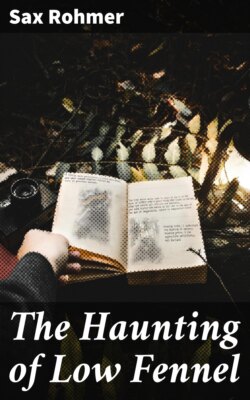Читать книгу The Haunting of Low Fennel - Sax Rohmer - Страница 4
На сайте Литреса книга снята с продажи.
II
ОглавлениеTable of Contents
Filled with the liveliest curiosity, I set out to explore Low Fennel. First I directed my attention to the exterior, commencing my investigations from the front. That part of the building on either side of the door was evidently of Tudor date, with a Jacobean wing to the west containing apartments overlooking the lawn—the latter a Georgian addition; whilst the new east wing, built by Major Dale, carried the building out almost level with the clump of fir-trees, and into the very heart of the ferns and bushes which here grew densely.
There was no way around on this side, and not desiring to cross the lawn at present, I passed in through the house to the garden at the back. This led me through the northern part of the building and the servants’ quarters, which appeared to be of even greater age than the front of the house. The fine old kitchen in particular was suggestive of the days when roasting was done upon a grand scale.
Beyond the flower garden lay the kitchen garden, and beyond that the orchard. The latter showed evidences of neglect, bearing out the Major’s story that the place had been unoccupied for twelve months; but it was evident, nevertheless, that the soil had been cultivated for many generations. Thus far I had discovered nothing calculated to assist me in my peculiar investigation, and entering the house I began a room-to-room quest, which, beyond confirming most of my earlier impressions, afforded little data.
The tortuous stairway, which had been the scene of the event described by my host, occupied me for some time, and I carefully examined the time-blackened panels, and tested each separate stair, for in houses like Low Fennel secret passages and “priest-holes” were to be looked for. However, I discovered nothing, but descending again to the hall I made a small discovery.
There were rooms in Low Fennel which one entered by descending or ascending two or three steps, but this was entirely characteristic of the architectural methods of the period represented. I was surprised, however, to find that one mounted three steps in order to obtain access to the passage leading to the new wing. I had overlooked this peculiarity hitherto, but now it struck me as worthy of attention. Why should a modern architect introduce such a device? It could only mean that the ground was higher on the east side of the building, and that, for some reason, it had proved more convenient to adopt the existing foundations than to level the site.
I returned to the hall-way and stood there deep in thought, when the contact of a rough tongue with my hand drew my attention to a young Airedale terrier who was anxious to make my acquaintance. I patted his head encouragingly, and, having reviewed the notes made during my tour of inspection, determined to repeat the tour in order to check them.
The Airedale accompanied me, behaving himself with admirable propriety as we passed around the house and then out through the kitchens into the garden. It was not until my journey led me back to the three steps, communicating with the new wing, that my companion seemed disposed to desert me.
At first I ascribed his attitude to mere canine caprice. But when he persistently refused to be encouraged, I began to ascribe it to something else.
Suddenly grasping him by the collar, I dragged him up the steps, along the corridor, and into the Major’s study. The result was extraordinary. I think I have never seen a dog in quite the same condition; he whimpered and whined most piteously. At the door he struggled furiously, and even tried to snap at my hand. Then, as I still kept a firm grip upon him, he set out upon a series of howls which must have been audible for miles around. Finally I released him, having first closed the study door, and lowered the window. What followed was really amazing.
The Airedale hurled himself upon the closed door, scratching at it furiously, with intermittent howling; then, crouching down, he turned his eyes upon me with a look in them, not savage, but truly piteous. Seeing that I did not move, the dog began to whimper again; when, suddenly making up his mind, as it seemed, he bounded across the room and went crashing through the glass of the closed window into the rose bushes, leaving me standing looking after him in blank wonderment.
